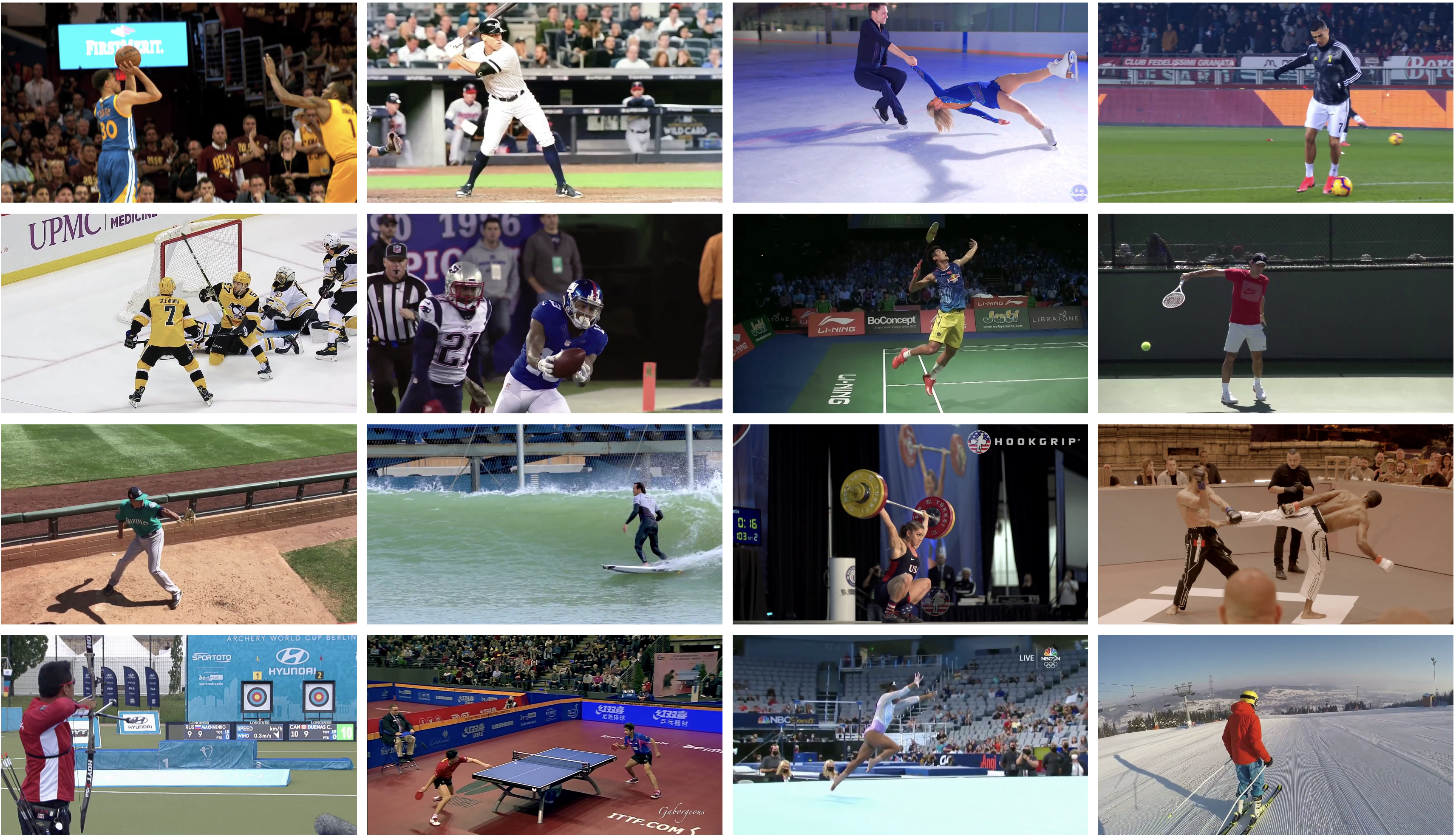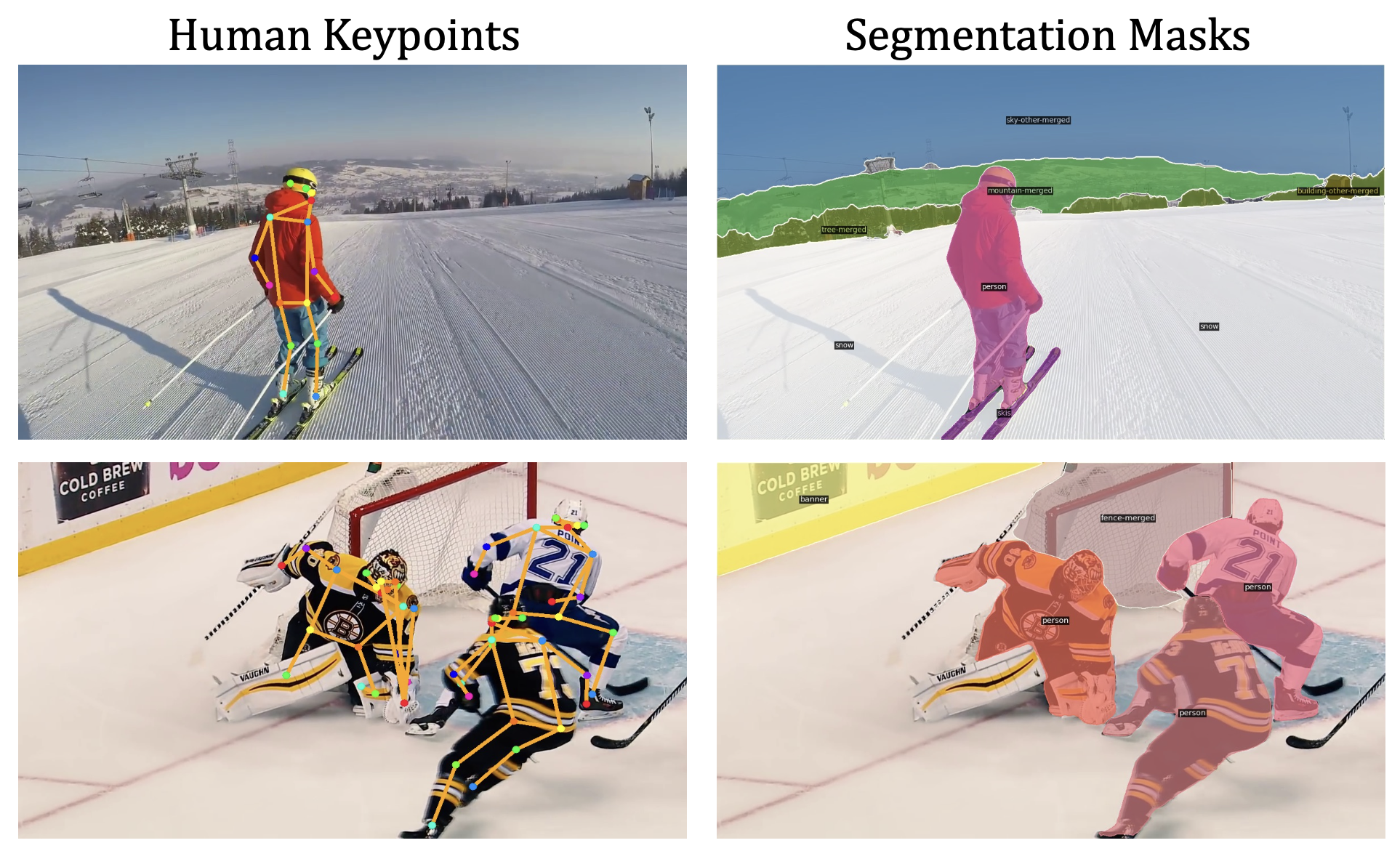This is the official repository of SportsSloMo (CVPR 2024)
[ArXiv Paper] [Demo(YouTube)] [Project Page]
We provide the video clips along with the code and trained weights for SportsSloMo. If you find this repository useful, please consider citing our paper.
We propose a challenging dataset consisting of high-resolution (≥720p) sports videos with careful curation, tailored for human-centric scenarios. Our dataset covers 22 various sports categories with different content and motion patterns, including hockey, baseball, skating, basketball, running, volleyball, etc.- SportsSloMo Dataset
- Requirements
- Video Frame Interpolation
- Human-aware Loss Terms
- Acknowledgement
- Reference
- Contact
Our dataset is targeted for human-centric scenarios covering various sports, and we provide over 8k long video clips that can be used for video frame interpolation, video super-resolution, group activity recognition, and dynamic view synthesis.
Video sequences of SportsSloMo dataset can be downloaded at the link.
Note that the data that we provide in the link is video files, additional processing is needed to extract frames from these video clips. Please consider following the step in the Preparation part below.
Our dataset has the following directory format:
├──── SportsSloMo_frames/
├──── clip_0000/
├──── frame_0000.png
├──── ...
├──── clip_0001/
├──── frame_0000.png
├──── ...
├──── ...
mkdir SportsSloMo_video
cd SportsSloMo_video
## Download sportsslomo_video_seqs.zip to this directory
unzip sportsslomo_video_seqs.zip
## Extract frames for each clip
cd SportsSloMo_EBME
python scripts/extract_frames.py
In this repo, we provide the environment setting and sample code needed for plugging in auxiliary losses into the EBME model, and other VFI models are also compatible unless specific packages need to be installed.
Our code is implemented using PyTorch 1.12.1 and Cuda 11.3, and we use CuPy package for forward warping operation (check softmax-splatting for details).
Create a conda environment and install dependencies:
git clone https://github.com/neu-vi/SportsSloMo.git
cd SportsSloMo_EBME
conda create --name SportsSloMo python=3.8
conda activate SportsSloMo
# Install the according versions of torch and torchvision
pip install torch==1.12.1+cu113 torchvision==0.13.1+cu113 torchaudio==0.12.1 --extra-index-url https://download.pytorch.org/whl/cu113
# Install required packages
pip install -U opencv-python
pip install -r requirements.txt
# Install the according version of CuPy
pip install cupy_cuda113==10.6.0
## Install packages for Mask2Former
# Install detectron2, note that gcc & g++ ≥ 5.4 are required.
pip install ninja
git clone https://github.com/facebookresearch/detectron2.git
cd detectron2
pip install -e .
# Install Mask2Former
cd ..
git clone https://github.com/facebookresearch/Mask2Former.git
cd Mask2Former
cd mask2former/modeling/pixel_decoder/ops
sh make.sh
We provide instructions and code for conducting Video Frame Interpolation on our SportsSloMo dataset using the baseline EBME as an example.
cd SportsSloMo_EBME
mkdir splits
Then download our split files for training/testing from this link to splits/ folder.
bash train_SportsSloMo.sh
Adjust CUDA_VISIBLE_DEVICES and other distributed training parameters in this file according to your machine, and set the data_root to where you store the SportsSloMo video frames.
bash benchmark_sportsslomo.sh
We put the checkpoints of our pre-trained models on SportsSloMo dataset at link. Please set te data_root to where your store the SportsSloMo video frames. The checkpoints with suffix "SportsSloMo" are our trained models with auxiliary losses, the checkpoints with suffix "EBME" are our trained baseline models.
To improve the existing video frame interpolation models on our human-centric SportsSloMo benchmark, we introduce two loss terms considering the human-aware priors. We propose loss terms based on human segmentation in the panoptic setting and human keypoints estimation as extra supervision for intermediate frame synthesis.
Both of our proposed human-aware loss terms are model agnostic and can be easily integrated into any video frame interpolation approach.We provide scripts and instructions to acquire ground-truth segmentation masks for our human-aware loss terms.
Note that large storage space is needed to store the extracted data, so make sure that there is enough storage space in your machine:)
# Install ViTPose_pytorch
git clone https://github.com/jaehyunnn/ViTPose_pytorch.git
cd ViTPose_pytorch
mkdir checkpoints
# download model to this directory [link](https://1drv.ms/u/s!AimBgYV7JjTlgTBm3dCVmBUbHYT6?e=fHUrTq)
# Install Yolov8
pip install ultralytics
# Download Mask2Former Checkpoint
cd Mask2Former
mkdir checkpoints
# download model to this directory [link](https://dl.fbaipublicfiles.com/maskformer/mask2former/coco/panoptic/maskformer2_swin_large_IN21k_384_bs16_100ep/model_final_f07440.pkl)
# Extract segmentation masks for auxiliary loss terms
python extract_segmentation.py
# Train the auxiliary loss with keypoints
# Build a soft link of ViTPose_pytorch to core/modules
cd SportsSloMo_EBME/core/modules
ln -s ../../../ViTPose_pytorch/ .
bash train_sportsslomo_kptaux.sh
Adjust CUDA_VISIBLE_DEVICES and other distributed training parameters in this file according to your machine, and set the data_root to where you store the SportsSloMo video frames.
# Train the auxiliary loss with segmentation masks
# Unzip the modified version of detectron 2
cd SportsSloMo_EBME/core/modules
unzip detectron2_modify.zip
cd ../../
bash train_sportsslomo_segaux.sh
Adjust CUDA_VISIBLE_DEVICES and other distributed training parameters in this file according to your machine, and set the data_root to where you store the SportsSloMo video frames. Remember to change "self.seg_root" in core.dataset.SportsSloMoAuxDataset to your own path storing segmentation masks.
# Train the full auxiliary loss
bash train_sportsslomo_aux.sh
Again, adjust CUDA_VISIBLE_DEVICES and other distributed training parameters in this file according to your machine, and set the data_root to where you store the SportsSloMo video frames.
Our code is based on the implementation of EBME, XVFI, RIFE and softmax-splatting. We also borrow code from Mask2Former, YOLOv8, ViTPose_unofficial and ViTPose. We sincerely thank those authors for their great works. If you use our codes, please also consider citing their nice works.
Jiaben Chen and Huaizu Jiang "SportsSloMo: A New Benchmark and Baselines for Human-centric Video Frame Interpolation"
BibTeX
@inproceedings{chen2023sportsslomo,
title={SportsSloMo: A New Benchmark and Baselines for Human-centric Video Frame Interpolation},
author={Chen, Jiaben and Jiang, Huaizu},
booktitle={CVPR},
year={2024}
}If you have any questions, please send an email to [Jiaben Chen] - jic088@ucsd.edu
The source codes and datasets can be freely used for research and education only. Any commercial use should get formal permission first. For such requests, please reach out to Prof. Huaizu Jiang - h.jiang@northeastern.edu.





